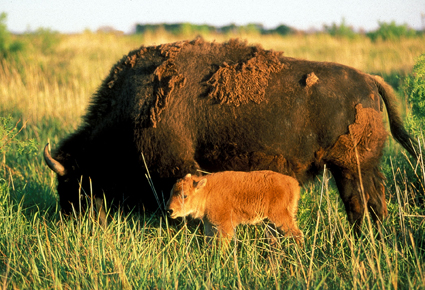
QUITAQUE – Eighty descendants of the great Southern Plains bison herd that numbered in the tens of millions in the mid-19th century will once again roam the range of their ancestors at Caprock Canyons State Park. Watch the video here.
That means that for the first time since remnants of legendary Panhandle pioneer rancher Charles Goodnight’s historic herd were introduced to the park in 1998, visitors will be able to have an up-close, Yellowstone-type encounter with the shaggy beasts. Up until now, the official state bison herd, confined to a 300-acre area of the park, could only be viewed from a considerable distance.
The bison’s new range will consist of more than 700 acres of restored native grass prairie in front of the Visitor Center and on the north and south sides of Theo Lake, where they will be fenced off from the campgrounds and day use area, according to park superintendent Donald Beard, who notes the bison will be in a “semi-free-ranging state” inside a perimeter fence.
“This is first and foremost a restoration project,” Beard says, “not an exhibit. We’re not just showing the bison, but are restoring an indigenous animal to its native habitat. For park visitors, it will be just like experiencing deer, roadrunners or any other wildlife in the wild. But it’s important to remember that the bison have the right-of-way and need to be given a large buffer zone.”
An official ribbon cutting marking the completion of Phase I – the release of the bison into an expanded range — is scheduled for 9 a.m., Saturday, Sept. 17 to kick off the Caprock Partners Foundation’s Texas State Bison Herd Restoration Celebration. Weekend entry fees will be waived. From 10 a.m. to 5 p.m., Saturday, living history exhibits, interactive displays and food and drink booths will be open. At noon, a $10 bison burger meal will be served, with proceeds going toward the bison restoration project.
Beard notes that when people drive into the park, they will be entering the bison’s range so will have to stop to let them cross the road. New entry signs posted will warn visitors of the bison’s presence and urge caution around the beasts that weigh up to 2,000 pounds. Rearview mirror-hanging park entry permits will remind motorists: “Warning: Bison are wild animals, do not approach.”
The Texas Parks and Wildlife Department has made safety and education the watchwords for Phase I of the park’s bison restoration project. At check-in, park customers will receive an informational brochure about the bison that reminds visitors to get no closer to the animals than 50 yards and to not feed or harass the bison. Any violation is a Class C misdemeanor and will be enforced.
Future phases of the bison project, which depend on adequate funding, have as the ultimate goal the restoration of the herd to the park’s entire 15,000-acres.
The small Texas State Bison Herd is all that remains of the vast Southern Plains herd that prior to the 1870s numbered between 30 million and 60 million head. The American bison were almost totally wiped out when the last of the Plains Indians were driven from their homeland and the railroad brought hordes of buffalo hunters who slaughtered the animals for their meat, hides and horns.
The Goodnight Herd was one of the five foundation herds that supplied stock to save American bison from extinction and the only Southern Plains bison herd established. Caprock Canyons bison are the last descendants of the herd that supplied wild stock for Yellowstone National Park and some of the largest zoos and ranches in the nation. The bison donated to the state by JA Ranch owners Monte Ritchie and Ninia Bivins were sent to Caprock Canyons and genetically tested. TPWD kept only those which had no cattle DNA.
Through continued study and genetic mapping of the Texas State Bison Herd, researchers have isolated three unique genetic markers in their DNA. Found only in the Goodnight Herd descendants, presence of these genes supports the claim that these animals are all that remain of the Southern Plains subspecies and are separate from Northern Plains and Woods bison subspecies.
Concerned about an increasing high newborn mortality rate within the captive Texas herd, TPWD wildlife biologists have over the years brought in new bison bulls from out of state to introduce new DNA. Park officials and geneticists believe greater genetic diversity will result in a larger and healthier herd.
Caprock Canyons State Park is located about 50 miles northeast of Plainview on FM 1065 approximately 4 miles north of State Highway 86. For more information, call (806) 455-1492 or visit the TPWD Website.
– SOURCE TPWD


